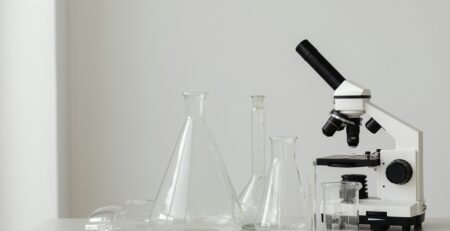4
Sep
Separatory Funnels in Organic Chemistry: Choosing PTFE vs Glass Stopcocks
Separatory funnels are indispensable in organic chemistry, enabling liquid–liquid extractions with accuracy and safety. They are commonly made from borosilicate glass (BORO 3.3) for durability and chemical resistance, and come with either PTFE or glass stopcocks. The choice between these materials significantly impacts usability, maintenance, and longevity.
Stopcock Options: PTFE vs Glass
The stopcock is the most critical component of a separatory funnel. It regulates liquid flow and ensures leak-free operation.
- PTFE Stopcocks
Known for chemical resistance and smooth operation, PTFE stopcocks are virtually maintenance-free. They do not require greasing, making them ideal for organic solvents, corrosive chemicals, and frequent use. - Glass Stopcocks
Favoured for their robustness and precise control, glass stopcocks are heat-resistant and compatible with flame-sealing applications. However, they require greasing to maintain a tight seal and prevent sticking.
Why Borosilicate Glass Funnels Excel
Borosilicate 3.3 glass is the material of choice for separatory funnels because it offers:
- Excellent thermal shock resistance during heating and cooling cycles.
- High chemical durability against acids, alkalis, and solvents.
- Transparency for easy monitoring of phase separation.
- Dimensional stability and compliance with ISO and ASTM standards.
Applications in Organic Chemistry
Separatory funnels are widely used for:
- Solvent extractions in synthetic organic chemistry.
- Purification processes to separate compounds with different solubilities.
- Environmental testing for isolating contaminants in water and soil samples.
- Pharmaceutical and food industries where precise extraction is required.
By selecting the right stopcock material, laboratories can optimise workflow efficiency and reduce long-term maintenance costs.
Comparison Table: PTFE vs Glass Stopcocks
| Feature | PTFE Stopcock | Glass Stopcock |
|---|---|---|
| Chemical Resistance | Excellent, inert to most solvents | Good, but some chemicals may etch glass |
| Maintenance | No greasing required, low maintenance | Requires greasing to prevent sticking |
| Thermal Resistance | Limited at high heat | High, suitable for flame applications |
| Durability | Resistant to wear but can deform under force | Very robust but fragile if dropped |
| Ideal Applications | Routine lab use, corrosive solvents | High-heat, precision-controlled operations |
FAQs
Q1: Which stopcock type is better for routine organic chemistry labs?
PTFE stopcocks are preferred for routine work due to their ease of use, chemical resistance, and low maintenance.
Q2: Can PTFE stopcocks withstand heating?
PTFE can handle moderate heating but is not ideal for flame-based applications. Glass stopcocks are recommended where heating is required.
Q3: Why do glass stopcocks require grease?
Glass surfaces can seize under pressure or temperature change. Greasing ensures a smooth seal and prevents breakage.
Q4: Are separatory funnels autoclave-safe?
Yes, borosilicate funnels with either PTFE or glass stopcocks can be autoclaved, though PTFE may degrade with repeated high-temperature sterilisation.
References
- ISO 4800: Laboratory Glassware — Separatory Funnels.
- ASTM E1095: Standard Specification for Glass Separatory Funnels.
- ISO 3585: Borosilicate Glass 3.3 — Material Properties.
- University of Sydney Organic Chemistry Lab Manual.
- NIST Chemistry WebBook, National Institute of Standards and Technology.

